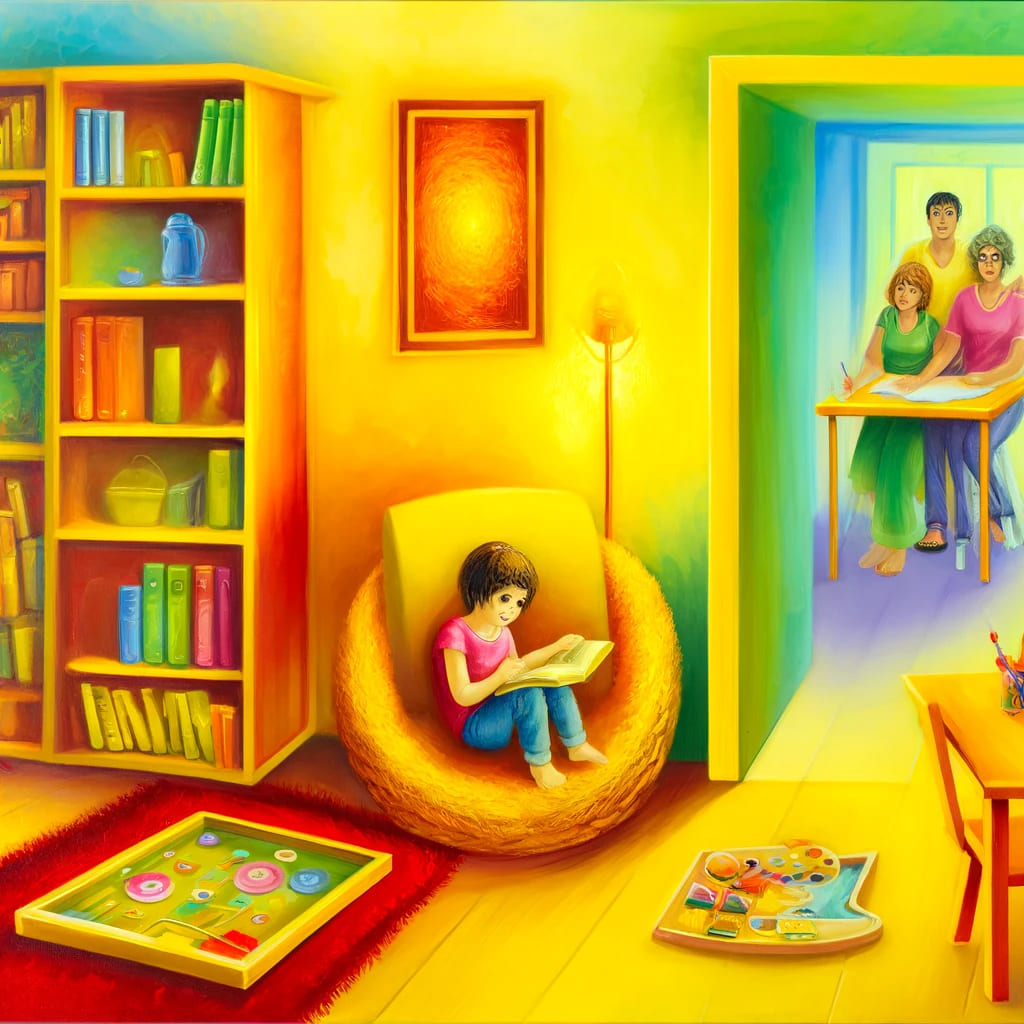Welcome to the Home Well Hub, where nurturing and caring for your family continue to be the centerpiece of everything we do. “Joyful Kids: 5 Effective Raising Techniques” is your daily run-in guide for turning commonplace difficulties into possibilities for joy. Whether you are trying to fend off tantrums, looking for ways to boost your child’s confidence and happiness, our ideas cover these bases and much more. You should be able to raise a healthy and contented child who is happy using the strategies presented in this article. Please come along with me on this journey.

Joyful Kids: Introduction
Introducing Sarah, a mom of two and her most common daily challenge. Yes, I said common, but definitely not easily surmountable: morning chaos. Day after day, with harried breakfasts and emotional outbursts, it seemed that stress was ruling at the start of each and every day. On a mission to change this cycle, Sarah set out to help guide and coach parents in setting up a more joy-fostering environment for their children. She discovered five powerful tools along the way that took the chaos out of her mornings and brought both her and her kids more joy. Our aim in sharing Sarah’s story is to share some really practical and effective strategies of nurturing joy and positivity in your children’s life so that they have a much smoother and happier start to the day.
Read More: Top 10 Secrets to Raising Healthy, Happy Kids
Joyful Kids: Emphasizing Positive Reinforcement

First and foremost, Sarah brought with her the positive tool of reinforcement. She began praising their smallest accomplishments, like being ready on time and eating breakfast without a fuss. Every praise built toward a more confident child, and she really started to brighten their mornings.
She always just selected the words and moments carefully. It had to be, so she praised specifically and sincerely. So instead of saying, “good job,” Sarah would say, “I’ve seen how you have helped your brother with the shoelaces today; it was very kind!” It helped her kids realize what kind of behavior is appreciated for repetition.
The implementation of this technique did not take any extra time or even the resources; it just took a twist in perspective. Sarah was now looking for opportunities to praise rather than to correct. This doesn’t develop the conduct of children, but it also deepens the emotional relation, feeling more valued and understood.
With warm and fuzzy positive reinforcement, Sarah has changed the home’s morning routine from a battle to a cheer-filled team sport full of smiles. This turned out to be quite simple yet very effective in creating a joyous environment, whereby the children even became more willing to participate in the daily task and eventually reduced the stress at home.
Joyful Kids: Creating a Supportive Home Environment

Building on the foundation of positive reinforcement, Sarah’s next step was to make the home a supportive environment that allowed emotional security. In other words, she fully understood that a home should be kind of a sanctuary, a place from which children would seek solace. It is where they feel free to share their feelings and ideas without being condemned and criticized.
She started by designating space in the house to its use. She set up a reading nook with soft cushions and all the books and even an area to do creativity work, including drawing stuff and crafts. Those dedicated spaces had invited her children to activities, allowing them to express themselves, so they derived joy and soothing to bring the home into more harmony.
She also had a schedule that made sure there was quality time with the family; there would be nights that the family would do things together, such as playing games with each other or having a movie night. This would further create the cohesion in the family and make the children feel they belong and have stability. These activities did not just keep them fun but were also emotionally important, since they allowed these children to feel interconnected and cherished.
That made Sarah manage to reel in the behaviors and increase the overall happiness of her children through turning her home into a environment supportive and stimulating. “This method brought to light the critical role that a home of nurturing plays in the raising of a joyful child who can walk out into the world and stand up with confidence.”
Read More: Social Media Responsibility: 10 Ways to Teach Children
Joyful Kids: Encouraging Social Interaction

Third approach that Sarah made use of was that of encouraging the children into the company of friends. She very much knew that social interactions highly played a role in the emotional and social development of children. She made sure that I attended play dates, which would encourage participation in group activities like sports classes and arts classes, where teamwork and communication are inculcated.
She noted that her children always had better social skills, such as empathy and conflict resolution, when relating with other people.
She even made sure that she discussed with her kids these experiences later on, reminding them of all the lessons learned during this time the social interactions were happening. In that manner, her children saw the different perspectives which would generally vary from one person to another, aside from realizing value in friendships.
Sarah took time to teach the kids the concept of community. She made them get involved in community service activities that widened their social circles and allowed them to develop a sense of responsibility and participation in community involvement. It was through these intentional acts that Sarah’s children were equipped in their abilities to interact and/or have a sense of social belonging or, in human terms, “fit in.” What it eventually proved to be for their children is a key element of developing great relational and emotional intelligence—both of which are key factors in long-term contentment.
Joyful Kids: Fostering Independence

The fourth avenue Sarah used in bringing up happy children was through independence. She started by giving them some duties, like laying tables, or preparing laundry, according to their ages, and a lot more. With time, the children learned how to do such duties, feeling accomplished and independent.
To support this development, Sarah made sure to create an environment where mistakes were seen as learning opportunities rather than failures. She encouraged her kids to seek the solutions to their problems and solve them by themselves first before she could step in. She did it with the aid of gentle questions that enabled them to find the solutions. This truly built on both their problem-solving skills and confidence.
Also, Sarah brought the concept of personal projects for the children. It was in such a way that each and every child could take some kind of activity or project of their choice forward, like making a model airplane or having a small garden of vegetables. She provided the necessary resources and guided the children but made them solely responsible for the project management and completion.
As Sarah gave them the reins more and more, and with it a bit of independence and the accompanying responsibility, she saw their self-esteem and general happiness go through the roof. The method had not only enabled her children to feel able but had also taught the value of independence, thus preparing them for future struggles.
Joyful Kids: Incorporating Play and Creativity

Fifth, Sarah introduced play and creativity into their daily activities, recognizing these elements as vital for both cognitive and emotional development. She allocated part of each day to unstructured play, allowing her children to freely use their imaginations, whether building with blocks, playing dress-up, or drawing. These activities were essential in fostering creativity and joy.
She also introduced themed activity days that excited the children and created anticipation. For example, “Science Sunday” involved simple experiments that children could perform at home, while “Make-Believe Monday” encouraged different plays and storytelling. Such themed days not only broke the monotony of the daily routine but also provided a fun and engaging way for children to continue learning.
Sarah ensured that the creative activities weren’t confined indoors. By taking activities outside, such as trips to the park or nature walks, she helped her children explore and interact with the environment in playful ways. Activities included collecting leaves, spotting wildlife, and imagining the life of bugs—all parts of Sarah’s strategy to integrate learning within play.
By making play and creativity regular parts of their lives, Sarah cultivated her children’s love for exploration and learning. This approach enhanced their creativity, significantly contributing to their well-being and overall happiness.
Joyful Kids: Conclusion
And yes, as we close out this story of Sarah, the mornings of her life certainly changed from chaos to a morning peaceful. The methods she has used—that of positive reinforcement, creating an enabling environment, encouragement of social contacts, gaining independence, and introduction of games—has not only made her children happy but also brought peace and harmony at their house. These strategies are both remedial and restorative, seeking to build a base of joy and resilience in children. When you apply these to your parenting, you, too, are going to see a difference in your child. A difference in their happiness and well-being, a little brighter day, and each challenge they face, a little more possible.
Read More: Wall Painting: 5 Pocket Friendly Hacks
Joyful Kids: Learning Outcome
The crux of the story of Sarah is the heavy impact of how parents’ emotional health lies in intentional strategies of parenting. Through methods of positivity, support, social skills, independence, and creativity, parents can bring a big difference in the overall happiness of their ward. This is a helpful way not only for immediate behavior challenges but also for equipping children with emotional resilience that will carry through to future success and fulfillment.
Joyful Kids: Key Takeaways
– Positive reinforcement increases joy. Incessant acknowledgment of his or her victories—howsoever small—could surely enhance your child’s joy and confidence level.
– A Supportive Home is Essential: Creation of emotionally safe spaces at home supports feelings of safety and fostering your child’s sense of belonging, which is very essential for their growth.
– Key to Social Skills: Children need to be afforded a chance where they humanly interact with peers in order for them to learn their empathy, teamwork, and communication.
– Independence Breeds Confidence: Children grow in confidence when age-appropriate responsibilities are given to them. They gradually gain self-reliance and independence in what they do.
– Creative Play Stimulates Development: Two of the most fundamental building blocks in fostering cognitive development and emotional prosperity in kids are the elements of creativity and play in daily routines.
FAQs
Q1: How do you raise a joyful child?
Raising a happy child involves the development of an environment that will enhance emotional well-being and resilience. Key strategies include humanly offering consistent love and support, practicing positive reinforcement to gain their cooperation in desired behaviors, providing opportunities for play and creativity, teaching them how to establish and develop friendships, and guiding them toward independence by giving them appropriate responsibilities.
Q2: How to raise successful and happy kids?
This is a brilliant article that has some great tips on how to raise successful, happy kids by balancing discipline and love, setting attainable expectations, and developing their interests. Teach your children a growth mindset by appreciating their efforts as opposed to their innate talent so that they can face challenges positively. Also, instill values like empathy, patience, and perseverance, with sureness that the child has a firm emotional background, by being a part of their lives.
Q3: What are the five things that make kids happy?
1.Secure Relationships: Consistent and loving interactions with family members.
2. Games and Activities: Time to play different games and involve kids in various activities that show their curiosity and creativity.
3. Praises and Awards: Appreciation of their attempts and achievements, even if they are small.
4. Predictability: The environment in which the activities always take place.
5. Freedom of Exploration: Learning opportunities and freedom of exploration to be experienced independently.
Q4: What is joyful parenting?
Joyful Parenting is a view of the process of parenting; it brings a focus on getting happiness and fulfillment out of the process of being parents. It means that one treasured moments spent with children, looked at in a positive manner to challenging aspects of being a parent, and accentuated the challenges from which one gains strength for development. A happy parent provides a family environment having an emotional and social context for children to flourish.
Q5: What are the five positive parenting skills?
1. Empathic Communication: To understand and validate the feelings of the child.
2. Consistent Discipline: Setting clear expectations and consequences lovingly.
3. Active Listening: Pay complete attention to the kids when they are talking to allow mutual respect and understanding.
4. Problem-Solving: Teaching the children how to solve problems, i.e., the art of resolving.
5. Encouragement and Support: Motivating children toward the areas of their interests and passions, giving a strong base for an experiment.